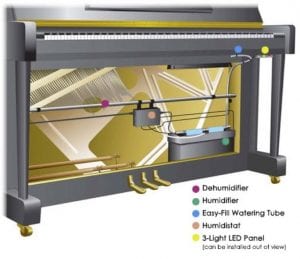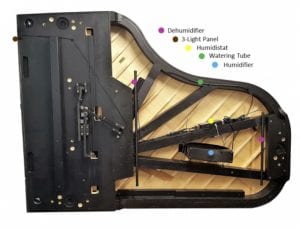Do I need a piano humidity control system?
April 9, 2020 •Chuck Johnson
Steinway Technician Jonathan Kotulski takes a look at the Dampp Chaser Humidity Control System in this informative post.
Humidity Control in Pianos - or - "What do you think of Dampp-Chasers?"
Anyone inside the piano business whether in sales, education, or technical work gets asked this question frequently. What do we think? The quick answer is - ready for this - it depends!
Many differing opinions are floating around as to what is the best way to provide humidity control for a piano. The popular opinions passionately expressed in favor of or against Dampp-Chaser units tend to be rooted in sincerely held beliefs. It is important to understand the facts as well as the motivations behind differing opinions.
This warrants a deep dive into all the factors that contribute to this important decision of whether or not to get a Dampp-Chaser installed in your piano. They are useful humidity control units in most situations. They are not the best practice for humidity control in some situations. Sometimes they should not be used under any circumstances. And they pose a unique challenge for new pianos.
Manufacturer and Dealer Policy
Steinway & Sons does not cover warranty repairs on issues that were caused (or potentially caused) by Dampp Chasers. M. Steinert & Sons does not advocate for Dampp-Chaser products for new pianos under warranty, except where extreme temperature and humidity fluctuations necessitate their use, such as in many schools and churches.
The essential reason for this is that these units do not do enough to address the problem of humidity control.
Dampp-Chasers create a small localized ideal environment for the piano in the immediate surrounding areas of the piano, specifically maintaining humidity levels at the soundboard, bridges, and strings.
In regards to the grand piano, because of the location of the installed unit under the soundboard, Dampp-Chasers do not bring humidity control to the pin block or the action. The pin block, or wrest plank, the laminated wood part that holds all the tuning pins at the proper tension, is one of the most important parts of the piano and is severely impacted by changes in temperature and humidity.
After a piano has gone through many dry weather cycles, the pin block wood will dry out, the tuning pins will loosen up, and tuning stability cannot be achieved. A Dampp-Chaser system in a grand piano does nothing to prevent damage to the pin block. It does however benefit the upright piano pin block to a certain extent because of its closed design.
The priority for a new piano owner is to be thinking about controlling the humidity/temperature environment of the room that the piano is in. It can be difficult to control the climate of a larger space, but that is exactly what the new piano owner is responsible to think about and implement.
When investing in a new piano, setting up a properly humidified room for the instrument is always the priority. A properly humidified room ensures that the whole piano is getting the benefits of stable humidity levels, whether the piano is under warranty or older.
Another reason manufacturers of pianos and dealers of new pianos do not endorse Dampp-Chaser systems for new pianos under warranty is because of potential problems with installations. If these systems are not installed correctly by certified installers who are professional piano technicians, there can be damage to the piano.
This is also a problem for the Dampp-Chaser company. For these reasons, manufacturers and dealers of new pianos tend to recommend Dampp-Chaser installations only after warranty periods have expired and still should be considered only as an addition to total room control.
What does Ideal Humidity Control look like?
A piano is at its happiest when it is kept in a museum-like environment: 42-43% relative humidity year round without fluctuation is the target. This keeps the soundboard from swelling with moisture in the humid summer season and shrinking as it dries out in the winter in response to central heating systems which dry out the air.
When the soundboard swells, it quite literally tightens the strings making them go up in pitch. And when the soundboard shrinks, the strings loosen and the pitch falls flat. The soundboard is a delicate membrane and amplifies the vibration of the strings. On a very small scale, the soundboard moves and vibrates to act as a transducer and project the soundwaves into the room. These are desirable movements of the soundboard.
However, humidity-related movements to the soundboard are unwanted and can be detrimental. These movements are not visible, but they happen reliably in reaction to the changing seasons. If you can get the soundboard completely immobile in response to the environment, then you have achieved ideal humidity control. Ideal humidity control also prolongs the life of the soundboard, and when controlling the entire room, the action parts, pin block, and case (furniture) also benefit.
In New England climates especially, the dry season usually has a greater effect, so that over time pianos tend to go flatter and flatter each year, if they are not in a controlled environment or getting tuned regularly.
When the tuning changes because of moisture levels in the wood, you can guarantee that the scientific principle of entropy - gradual decline into disorder - is at play. The piano will detune in a chaotic way that will sound unpleasant to the ear. Creating this stable 42% target is usually accomplished through air conditioning and dehumidifiers in the summer and humidifiers in the winter.
Piano owners often get overwhelmed when trying to choose a humidifier. Humidifier options are basically standalone units, HVAC units, or in-piano units like the Dampp-Chaser. It is true that a Dampp-Chaser is both a humidifier and dehumidifier, which is one of the advantages of using this machine.
What is a Dampp-Chaser and how does it work?
The Piano Humidity Control System
The Piano Life Saver System is completely silent and installed on the underside of your piano.
 Components:
Components:
- Dehumidifier: When the Humidistat senses the humidity level is too high, the Dehumidifier carries away moisture on warm air currents until the Humidistat senses that the humidity level is appropriate.
- Humidifier: When the humidity is too low, the Humidifier adds moisture to the air inside the piano until the Humidistat senses that the RH level is high enough.
- Watering Tube: When the yellow light blinks, the watering tube permits you to easily add water to the System.
 Humidistat: This is the brain of the System. It senses whether the micro-climate within your piano is optimal and automatically switches the System to function as a Dehumidifier or Humidifier to protect your piano from damage caused by changes in humidity.
Humidistat: This is the brain of the System. It senses whether the micro-climate within your piano is optimal and automatically switches the System to function as a Dehumidifier or Humidifier to protect your piano from damage caused by changes in humidity.- 3-Light LED Panel: The panel features a green light marked POWER to indicate the System has electrical power and a yellow light marked WATER which blinks when the Humidifier needs water. If the System includes the optional Smart Bracket on the Humidifier tank, the red light marked PADS will blink when the pads are no longer wicking water, indicating they should be replaced.
Other Dampp-Chaser considerations:
Dampp-Chasers must be installed by certified installers who are also professional piano technicians. They can only be purchased through certified technicians or dealers like M. Steinert & Sons.
- Dampp-Chasers should never be installed in a piano with any electronics, such as player pianos or pianos with MIDI sensors.
- Dampp-Chasers are not worth installing in many older pianos, pianos that may be too worn out to benefit from the system. Also, some older pianos have very old Dampp-Chaser systems in them which may not work properly. These should be discarded to avoid damage to the piano.
- Dampp-Chasers are completely useless if they get installed and then do not get filled with water! Also useless: a high-end HVAC system or nice standalone humidifier that, once installed, does not get routine maintenance. There must be a concerned party on the other end of the installation, someone who is responsible for the piano and completes the required maintenance on the humidity system.
- Dampp-Chasers require minimal maintenance. When the water light blinks, the piano owner must fill the unit with water every two weeks or so, making sure to use the pad treatment solution and get the pads changed every year to prevent mineral and mold build-up. Only the pad treatment sold by Dampp-Chaser is safe to use with the system. Using something else will cause extreme damage to the soundboard, bridges, and strings. Often, the technician who installed the unit takes care of the pads, but it is very important that the piano owner keep filling it with water when the light blinks.
The Bottom Line:
Dampp-Chasers can make a good tuning last much longer, by immobilizing the soundboard, and keeping the same micro-environment for the string/soundboard system year round. However, they are not a replacement for getting the piano tuned.
And they are not a replacement for controlling the humidity level of the piano’s room. Dampp-Chasers are only recommended for pianos where room control is impossible or unaffordable. It is worth doing the research on humidifiers and taking measures to protect your investment, boosting the longevity of the instrument and the joy of music-making far into the future!
By Jonathan Kotulski, April 2020
Featured Articles
Categories
- Beginner Pianos (23)
- Boston Pianos (15)
- Comparisons (30)
- Designer and Specialty Pianos (8)
- Essex Pianos (10)
- Events (11)
- Featured (24)
- Institutional (3)
- Joy of Piano (15)
- Learning About Pianos (69)
- News (35)
- Pricing and Cost (19)
- Resource Center (122)
- Roland Pianos (6)
- Spirio (15)
- Steinway Pianos (70)
- Student (14)
- Teacher (13)
- Used Pianos (20)
- Videos (19)


